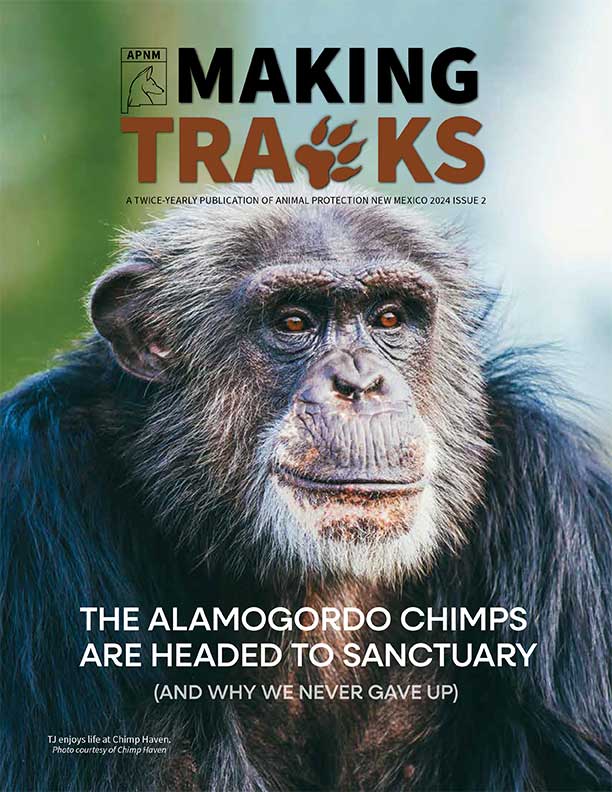 TJ enjoys sanctuary after enduring years of invasive testing on Holloman Air Force Base.
TJ enjoys sanctuary after enduring years of invasive testing on Holloman Air Force Base.
Photo courtesy of Chimp Haven.
For years, these government-owned chimpanzees were kept hidden on Holloman Air Force Base, denied the retirement they were promised. Through APNM’s efforts, alongside your voice and support, the federal government has finally fulfilled its obligation.
But as we celebrate this long-overdue justice, we must be clear: our work is not over.
Even though the U.S. officially ended invasive research on chimpanzees in 2015, more than 100 chimps are still confined in laboratories—mostly in Texas. Two facilities, the Keeling Center at MD Anderson Cancer Center in Bastrop and the Southwest National Primate Research Center in San Antonio, continue to house chimpanzees they claim are not federally owned – but privately owned. That legal distinction has allowed these institutions to avoid the sanctuary requirement, and for now, those chimps remain behind closed doors, waiting.
NIH, which pledged to retire all federally owned chimpanzees nearly a decade ago, has done little to challenge this status quo. That inaction has not gone unnoticed. Recently, members of Congress have started to demand answers. Journalists are asking tougher questions. And many of us who fought for the APF chimps are now turning our attention to those still left behind.
 Macaque monkey in laboratory.
Macaque monkey in laboratory.
Photo: AdobeStock
What’s more, the conversation has broadened. This isn’t just about chimpanzees. Across the country, tens of thousands of monkeys are still being used in biomedical experiments—many of them inside facilities known as National Primate Research Centers, or NPRCs.
These seven labs, located at major universities like the University of Washington and Emory, are receiving increased scrutiny for their secrecy, ethics, and scientific relevance.
 Protesters seeking the release of chimpanzees used in research. Yerkes National Primate Research, Atlanta, Georgia.
Protesters seeking the release of chimpanzees used in research. Yerkes National Primate Research, Atlanta, Georgia.
Photo: Jo-Anne McArthur / We Animals
Student protests are growing. Faculty members are speaking out. Legal actions are surfacing. The tide is turning, and people are demanding a research system that reflects both modern science and humane values.
That shift isn’t just about opposition. It’s about alternatives. And here’s where we believe New Mexico has something powerful to offer.
Our state is uniquely positioned to be a national leader in advancing human-relevant, non-animal research methods. National labs like Los Alamos and Sandia have already joined forces in a statewide AI initiative aimed at transforming biomedical innovation. LANL’s new collaboration with OpenAI is just one example of how powerful modeling and simulation can eliminate the need for animal-based testing entirely.
 Lung-on-a-chip, developed at Wyss Institute, Harvard University
Lung-on-a-chip, developed at Wyss Institute, Harvard University
Photo: Wyss Institute for Biologically Inspired Engineering, Harvard University
Meanwhile, the University of New Mexico is home to researchers working on technologies like organ-on-a-chip systems, machine learning platforms, and other next-generation tools designed to simulate human biology without using animals. These innovations are not theoretical—they’re working models that challenge the outdated justification for primate testing.
Even at the federal level, we’re seeing a shift. NIH recently launched the Office of Research Innovation, Validation, and Application—ORIVA—which is tasked specifically with advancing non-animal methods. The FDA has announced a roadmap to phase out animal testing in drug development. These moves are not only encouraging—they’re opening doors for states like ours to step up and lead.
I keep thinking about what the APF chimpanzees endured, and what it took to finally secure their freedom. It was never a given. It took persistence. It took pressure. It took a community that refused to let them be forgotten.
That same persistence is needed now—whether for the chimpanzees still in labs, or for the future of research that no longer depends on using primates at all.
We honored our promise to the APF chimps. Now we have a chance to carry that progress forward—not just for them, but for the kind of science, compassion, and leadership New Mexico can be known for.
Let’s keep going.
Gene Grant
Chief Program and Policy Officer – Animals in Science




